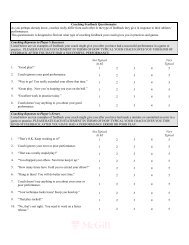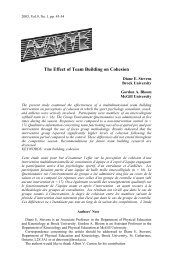International Journal of Sport Psychology
International Journal of Sport Psychology
International Journal of Sport Psychology
Create successful ePaper yourself
Turn your PDF publications into a flip-book with our unique Google optimized e-Paper software.
To further examine whether gaze behaviour differences across the two<br />
viewing conditions, as indicated by the post hoc tests, were related to<br />
performance scores, separate Pearson correlation analyses were conducted.<br />
For the stationary viewing condition, results revealed that watching the balland-stick<br />
combination and performance scores were positively correlated (r<br />
= .49, p < .05). In other words, goalkeepers who focused more time on the<br />
ball-and-stick location saved more penalties in the stationary condition.<br />
There were also correlations that showed trends approaching conventional<br />
levels <strong>of</strong> statistical significance. That is, goalkeepers that tended to look at the<br />
stopper were less successful in saving penalties (r = -.42, p = .076). Similar to<br />
the stationary condition, in the dynamic viewing condition watching the balland-stick<br />
combination was positively correlated with saving performance (r<br />
= .43, p = .065). Interestingly, goalkeepers who tended to visually overshoot<br />
the stopping location saved less penalties (r = -.42, p = .067).<br />
Discussion<br />
Previous research has focussed on dissociating visual information pickup<br />
differences between skilled and less skilled goalkeepers in penalty<br />
situations in soccer (Savelsbergh et al., 2002, 2005). While other studies also<br />
examined visual information pick-up in ice hockey (Panchuk & Vickers,<br />
2006; Salmela & Fiorito, 1979) and field hockey (Rendell & Morgan, 2005;<br />
Williams et al., 2002), this is the first study that examined the differences in<br />
visual information pick-up in field-hockey penalty corners within a group <strong>of</strong><br />
experienced hockey goalkeepers. Similar to Savelsbergh and colleagues<br />
(2002, 2005), we used direct measures <strong>of</strong> visual information pick-up (i.e.,<br />
gaze behaviour) and required more active responses (i.e., motor reactions<br />
with a joystick when compared to, for example, button presses). The<br />
goalkeepers were presented with video clips that were captured with either a<br />
stationary camera that was directed towards the stopper and the drag flicker<br />
or with a moving camera that followed the ball trajectory. Finally, we assessed<br />
the direct relationship between goalkeeping performance and gaze measures.<br />
Results showed that in the dynamic viewing condition (i.e., with the<br />
moving camera), goalkeepers fixated more on the ball than in the stationary<br />
condition. Thus, when goalkeepers had the chance to get more information<br />
about the ball trajectory after the pusher had played the ball towards the<br />
stopper, they tended to search for that information. Interestingly, however,<br />
this did not seem to be a beneficial strategy. In contrast to the stationary<br />
viewing condition, the goalkeepers tended to overshoot the stopping<br />
336




